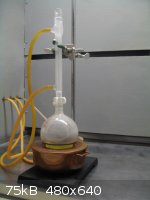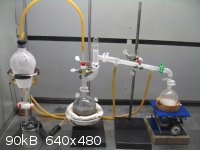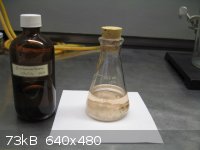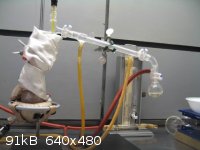freachem
Harmless

Posts: 14
Registered: 5-12-2006
Member Is Offline
Mood: fluid
|
|
o-toluidine from o-nitrotoluene
Hi
I recently attempted a reduction using HCl Sn and o-nitrotoluene, The problem I am having is removing the reduction product from the stannous
chloride. Any ideas? Filtration was unsuccesful as the material blocks up the filter. Using diethyl ether to extract left me with a homogenous aq
solution, steam stilling destroyed the product (left me with a blue black mess). These methods were tried before and after neutralising the acid. I
have been unable to find procedures using tin / iron etc.- no raney nickle anvailable at present
|
|
|
kafka
Harmless

Posts: 34
Registered: 26-7-2006
Member Is Offline
Mood: No Mood
|
|
how did you make the nitrotoluene? did you start with toluene or have you tried another method?
From Rhodiums chemistry archive:
o-Toluidine from Toluene
Nitrotoluene
Toluene is nitrated with a HNO3/H2SO4 mixture to yield o- and p-nitrotoluene.
Toluidine [7]
This should be performed in a strong, easily cleaned vessel, equipped with a powerful stirring device and a reflux condenser. This reaction can be
modified to use tin instead of iron. 60 cc of water and 120 g of fine, cleaned, iron powder are placed in the reaction vessel and vigorous stirring is
begun. The vessel contents are heated to 90-95°C and 10 cc of hydrochloric acid is poured in. 100 g of nitrotoluene (mono-nitrotoluene) is now added,
at such a rate as to hold the temp at exactly 100°C (a few ml at a time). After the addition is complete, the temp will have to be maintained at
100°C with the heating device until the smell of nitrotoluene is gone. Vigorous stirring must be used through the entire operation. Set the reflux
condenser to distill and lead steam directly into the vessel to steam distill the toluidine out of the reaction contents.
If available, use only o-nitrotoluene as substrate in this step, to save chemicals and the separation step can be omitted.
o-Toluidine [7]
The crude oily toluidine mixture from the above steam distillation is separated from the water, ice and salt are added to the oil, and the mixture is
stirred. A whitish-yellow crystalline compound appears, which is the hydrate of p-toluidine. This is filtered off through an ice cooled filter funnel,
and then is well pressed to remove any oily o-toluidine. The o-toluidine is separated from the filtrate with a separation funnel. This crystallization
should preferably be repeated to ensure that all p-toluidine is removed.
|
|
|
freachem
Harmless

Posts: 14
Registered: 5-12-2006
Member Is Offline
Mood: fluid
|
|
Hi Kafka
Thanks for the reply
I started with 40g toluene, I nitrated it using HNO3/H2SO4(ratios= 20% HNO3 20% water 60% H2SO4 by volume ), then steam distilled off the o-isomer
|
|
|
Magpie
lab constructor
    
Posts: 5939
Registered: 1-11-2003
Location: USA
Member Is Offline
Mood: Chemistry: the subtle science.
|
|
I have prepared o-toluidine with 22.7g of o-nitrotoluene using Vogel’s (3rd ed) “Method A” for aniline, at 0.82 scale. Adjustments were made
for the differing molecular weights of the respective precursors, nitrobenzene and nitrotoluene. Method A utilizes tin/HCl as reducing agent.
The reaction was conducted in a 500mL RBF. I had to reflux the reactants for the full 60 minutes before the almond-like smell of o-nitrotoluene had
all but disappeared. This was replaced with the mild naphthalenic smell of o-toluidine.

reactants at reflux
After basification the product mix was subjected to steam distillation. About 200mL of milky white emulsion came over. I continued collecting clear
condensate for another 100mL as recommended by Vogel due to the high solubility of the o-toluidine in water. My pot residue consisted of
stannous/stannic hydroxides that didn’t dissolve.

steam distillation of o-toluidine
I substituted DCM for ether to extract the o-toluidine from the steam distillate using 2 x 35 mL. The extract is shown here being dried over
potassium carbonate:

DCM extract of steam distillate, drying
The dried extract was distilled to remove the DCM using simple distillation. The crude o-toluidine in the pot residue was then purified by vacuum
distillation at 1-2mmHg absolute pressure, as shown below. The distillate temperature at this pressure was 52-55°C which is consistent with
o-toluidine’s normal boiling point of 200°C.

vacuum distillation of crude o-toluidine
The weight of product was 10.6g, indicating a yield of 60.0%.
Discussion
Once again I found the use of tin/HCl for the reduction of a nitro-aromatic to be facile.
About the only problem I had with this synthesis was some violent bumping when I first started the vacuum distillation. This was eliminated upon
installation of an ebulliator tube.
Questions/comments/suggestions are welcomed.
The single most important condition for a successful synthesis is good mixing - Nicodem
|
|
|
Metacelsus
International Hazard
    
Posts: 2531
Registered: 26-12-2012
Location: Boston, MA
Member Is Offline
Mood: Double, double, toil and trouble
|
|
Once again, trying to replicate a Magpie procedure here.
I have 128 g o-nitrotoluene (vacuum fractionated from a nitrotoluenes mixture). I'd like to reduce it to o-toluidine. However, I don't have tin; all I
have is iron. Therefore, I'm going to use iron instead, using Vogel's Method B (Magpie used Method A).
I'll start with a small run, and then scale up.
Planned reagents:
25 g iron filings
33 ml water
2.5 ml conc. HCl
20 ml o-nitrotoluene
[Edited on 21-10-2014 by Cheddite Cheese]
|
|
|
Scr0t
Hazard to Others
  
Posts: 118
Registered: 14-1-2012
Location: Europe
Member Is Offline
Mood: Desiccated
|
|
Steam distillation will work well here. Just basify the reaction mix with aqueous NaOH and then just boil the whole and distil your o-toluidine
across, no need for a separate vessel to generate steam although depending on the ratio of o-toluidine product to H2O you might need to
top-up with H2O in mid-distillation.
It will undergo some atmospheric oxidation that will give it some colour but it's perfectly usable.
If your o-toluidine was made from homemade o-nitrotoluene via nitration it may contain some p-toluidine that can clog the condenser during the tail
end of the distillation, depending on scale. The same is true in respect to the corresponding nitro compounds where a small but noticeable degree of
separation of isomers can be achieved by steam distillation.
Relying on steam distillation alone to separate isomers wont cut it.
Dithionite works well as mentioned elsewhere, even that Dylon pre-dye crap works well as a reducing agent here in-spite of the added perfume.
[Edited on 21-10-2014 by Scr0t]
|
|
|
Famousroger
Harmless

Posts: 23
Registered: 12-10-2014
Member Is Offline
Mood: No Mood
|
|
Large surface area zero valent iron is certainly effective for reduction of this nitro group. Above poster suggests iron filings; should be perfect.
I'm sure the net will provide examples - nitrobenzene to aniline using iron is common, this is absolutely analogous.
|
|
|
Famousroger
Harmless

Posts: 23
Registered: 12-10-2014
Member Is Offline
Mood: No Mood
|
|
ScrOt also makes good point regarding ortho-nitro contaminant; nitration will largely occur at para and ortho, with para likely to be dominant due to
steric effects, although methyl group isn't particularly large, so ortho-product will be something you will have to acknowledge if its not already.
|
|
|
Metacelsus
International Hazard
    
Posts: 2531
Registered: 26-12-2012
Location: Boston, MA
Member Is Offline
Mood: Double, double, toil and trouble
|
|
If I had sodium dithionite I'd use it. However, I can't seem to find any OTC products containing it, and ordering it online is not worth it.
I'm pretty sure I have o-nitrotoluene of high purity, so I'm not too worried about para contamination clogging the condenser.
By the way, I probably won't have time to do the experiment until the weekend.
[Edited on 21-10-2014 by Cheddite Cheese]
|
|
|
Magpie
lab constructor
    
Posts: 5939
Registered: 1-11-2003
Location: USA
Member Is Offline
Mood: Chemistry: the subtle science.
|
|
If you want to use tin, which I recommend over iron*, try looking in the fishing stores for tin weights. I've seen these at Walmart.
*(Iron is hard to keep in suspension and badly stains glassware.)
[Edited on 21-10-2014 by Magpie]
[Edited on 21-10-2014 by Magpie]
The single most important condition for a successful synthesis is good mixing - Nicodem
|
|
|
Bert
Super Administrator
        
Posts: 2821
Registered: 12-3-2004
Member Is Offline
Mood: " I think we are all going to die. I think that love is an illusion. We are flawed, my darling".
|
|
Quote: Originally posted by Magpie  | If you want to use tin, which I recommend over iron*, try looking in the fishing stores for tin weights. I've seen these at Walmart.
*(Iron is hard to keep in suspension and badly stains glassware.) |
Lead free solder... Or contact Rotometals
[Edited on 21-10-2014 by Bert]
Rapopart’s Rules for critical commentary:
1. Attempt to re-express your target’s position so clearly, vividly and fairly that your target says: “Thanks, I wish I’d thought of putting it
that way.”
2. List any points of agreement (especially if they are not matters of general or widespread agreement).
3. Mention anything you have learned from your target.
4. Only then are you permitted to say so much as a word of rebuttal or criticism.
Anatol Rapoport was a Russian-born American mathematical psychologist (1911-2007).
|
|
|
Metacelsus
International Hazard
    
Posts: 2531
Registered: 26-12-2012
Location: Boston, MA
Member Is Offline
Mood: Double, double, toil and trouble
|
|
Lead free solder is a good idea. I have some lying around that I don't use, because tin-lead solder works better. I guess the tin doesn't have to be
that pure.
I think I will give both tin and iron a try, and compare the results.
|
|
|
DJF90
International Hazard
    
Posts: 2266
Registered: 15-12-2007
Location: At the bench
Member Is Offline
Mood: No Mood
|
|
Quote: Originally posted by Famousroger  | | ScrOt also makes good point regarding ortho-nitro contaminant; nitration will largely occur at para and ortho, with para likely to be dominant due to
steric effects, although methyl group isn't particularly large, so ortho-product will be something you will have to acknowledge if its not already.
|
The thread is about reduction of the o-nitrotoluene. Regiomeric impurities in p-nitrotoluene are more easily controlled by
recrystallisation, and are less of an issue. You also seem oblivious to the statistical effect during the nitration of toluene - whilst the
para-position is less hindered, there are two ortho_positions, and so you end up with something like 60:40
o-:p-nitrotoluene
The use of iron as a reductant will benefit immensely from mechanical stirring.
[Edited on 22-10-2014 by DJF90]
|
|
|
Scr0t
Hazard to Others
  
Posts: 118
Registered: 14-1-2012
Location: Europe
Member Is Offline
Mood: Desiccated
|
|
My post was directed at the OP but I now see he hasn't been active since 2007.
|
|
|
Metacelsus
International Hazard
    
Posts: 2531
Registered: 26-12-2012
Location: Boston, MA
Member Is Offline
Mood: Double, double, toil and trouble
|
|
I've looked up the composition of my lead-free solder, and it's 3% silver, .5% copper, and the remainder tin. Thus, I think it should work well once
I've cut it up into little pieces.
For the Sn reduction on the same scale, I'll need:
39 g 96% Sn
85 ml conc. HCl
20 ml o-nitrotoluene
[Edited on 22-10-2014 by Cheddite Cheese]
|
|
|
Metacelsus
International Hazard
    
Posts: 2531
Registered: 26-12-2012
Location: Boston, MA
Member Is Offline
Mood: Double, double, toil and trouble
|
|
I've done both reductions, and I'm about to do the workups. I did the iron one on twice the originally planned scale because I realized I had 50 grams
of iron filings instead of 25. The tin reduction was surprisingly exothermic; a reflux condenser was definitely helpful. Magpie, you were right about
the iron staining glassware. However, I used a cheap Erlenmeyer flask, so I'm not too bothered.
|
|
|
S.C. Wack
bibliomaster
    
Posts: 2419
Registered: 7-5-2004
Location: Cornworld, Central USA
Member Is Offline
Mood: Enhanced
|
|
Quite a bit in Rust Raze (from Menard's), not enough to burn when heated in air maybe, but I suspect that it can be purified by dissolving and adding
Zn, SO2, etc.; i.e. a good start.
|
|
|
Metacelsus
International Hazard
    
Posts: 2531
Registered: 26-12-2012
Location: Boston, MA
Member Is Offline
Mood: Double, double, toil and trouble
|
|
Tin reduction yield: 11.24 g (62%). The o-toluidine is a pale yellow liquid, with an unpleasant smell.
Iron reduction yield: (coming soon, need to do final distillation)
I also have quite a bit of tin oxide (I haven't measured how much). Any ideas of what I could do with it? Thermite comes to mind . . .
|
|
|
Metacelsus
International Hazard
    
Posts: 2531
Registered: 26-12-2012
Location: Boston, MA
Member Is Offline
Mood: Double, double, toil and trouble
|
|
The Fe reduction yield is 19.58 g (54%). Thus, Sn gives better yields.
For easy storage, I want to prepare the HCl salt of this amine. Will just mixing it with hydrochloric acid and evaporating the water work? If not, why
not?
|
|
|
Dr.Bob
International Hazard
    
Posts: 2658
Registered: 26-1-2011
Location: USA - NC
Member Is Offline
Mood: No Mood
|
|
The HCl salt for form that way, but it might be hydroscopic, thus it may be hard to get and keep it entirely dry. But if you make it and then dry it
to a solid, and then seal it in a glass bottle, it should be stable. The o-toluidine should be reasonably stable, likely to darken with exposure to
air, but if tightly sealed, it would be fine for years I would think. Just try to find a small bottle to avoid much air in the bottle.
|
|
|
Metacelsus
International Hazard
    
Posts: 2531
Registered: 26-12-2012
Location: Boston, MA
Member Is Offline
Mood: Double, double, toil and trouble
|
|
Yes, the toluidine has already changed from pale yellow to a darker, almost orange, shade. I don't have it stored in a very small bottle; I estimate
it takes up slightly more than half the volume.
|
|
|
AvBaeyer
National Hazard
   
Posts: 644
Registered: 25-2-2014
Location: CA
Member Is Offline
Mood: No Mood
|
|
C. Cheese,
Did you distill your o-toluidine? In the past, I have distilled anilines under reduced pressure from a small amount of zinc dust. This gives a water
white amine which will stay nearly colorless for long periods if stored in a dark bottle with minimal air contact.
AvB
|
|
|